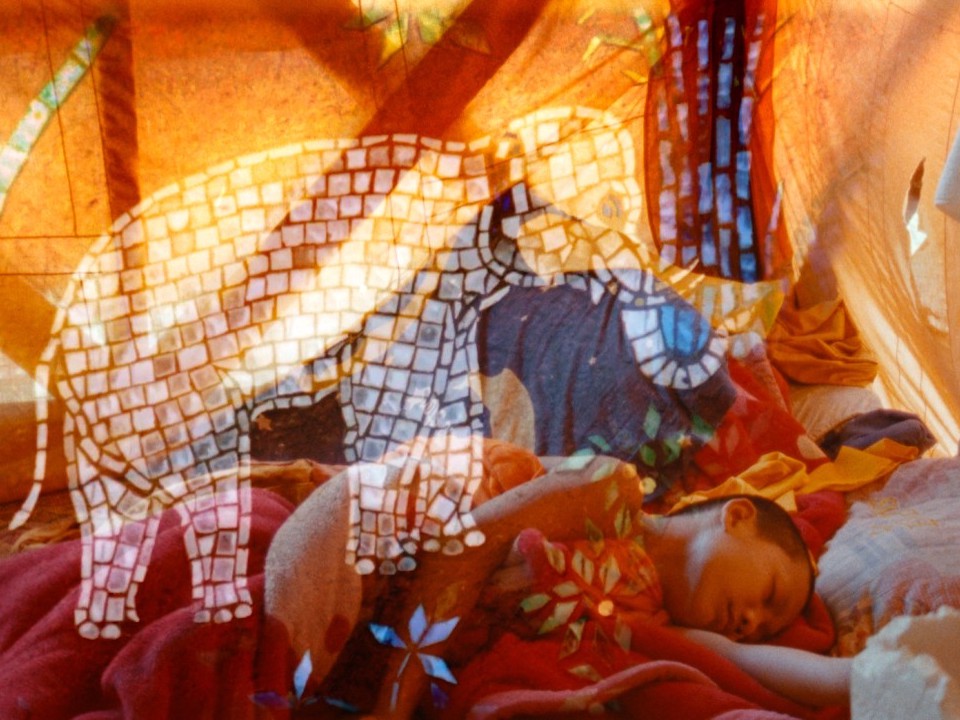
Every morning, a Buddhist teenager visits an elderly woman’s home to read her The Bardo Thödol, a guide for the journey between death and the next rebirth. On her last day, the young man whispers the book’s final passages in her ear, closes his eyes, and meditates alongside her, as she embarks on a transformative journey into what lies beyond.
EN
“‘Did you know that we keep on hearing after we’re dead?’ The question comes up early into Lois Patiño’s 16mm-shot Samsara but haunts the film from first shot to last, doubling as a précis of the multisensory feast this extraordinary journey through bodies, time and space packs throughout. ‘Watching’ is too restrictive a word for the kind of experience Patiño has arranged.”
Leonardo Goi1
“Samsara's middle third, an interactive trip through the Bardo, stands as one of the more extraordinary feats of expanded cinema in recent memory.”
Jordan Cronk2
“This 15-minute coup de cinéma – which, not to put too fine a point on it, is the film’s raison d’être –links up with two important experimental film traditions. The first is that of Gene Youngblood’s expanded cinema, expounded in his classic text of the same name, which in its widest meaning designates ‘an attempt to approximate mind forms.’ (...) The second experimental tradition Samsara relates to is that of the flicker film. Samsara’s originality, then, lies in fusing the psychedelic, mandala-like forms of Jordan Belson's or James Whitney's expanded cinema with an ingenious development of the flicker film.”
Lawrence Garcia3
“Samsara delves into some constants that I have been exploring in my work: the reflection on the relationship between the human being and the landscape, an anthropological interest focused especially on the mythical, spiritual, or the will to take the viewer to an intimate and meditative experience. In my previous films, I have developed concepts that tend to ‘empty’ the image, such as distance, duration of immobility. The human figures in these films appear very distant or paralyzed, suggesting a disappearance, a dilution of the human being in the landscape. In Samsara I continue to work from the Freudian concept of the ‘oceanic feeling’: to be feeling as part of the whole, as the drop of water is an indivisible part of the ocean; an idea of spiritual communion also present in the concept of Buddhist Enlightenment that the project explores.
In Samsara I wanted to take this ‘emptying’ of the image one step further and explore more deeply the idea and representation of the invisible in cinema. That’s when the idea came up to make a film which should be watched with your eyes closed. I wanted the cinematic experience to be closer to the meditative one, and for the theatre to become a space for collective meditation. On the other hand, I find interest in the multiplication of the image provoked by the gesture of closing our eyes. That way the sound will evoke different images to each viewer. This also allows a singular perceptive experience derived from the fact that it is the eyelid, soaked in light, which becomes the screen. The Tibetan Book of the Dead – a detailed description of what we will find in the afterlife – seemed to me an optimal place to develop this cinematographic proposal of closed eyes, as it is a spectral space, where the evanescent and fleeting acquire greater presence.”
Lois Patiño4
- 1Leonardo Goi, “Berlinale Review: Samsara,” The Film Stage, February 22, 2023.
- 2Jordan Cronk, "Planting Seeds: Jeonju 2023," Film Comment, May 15, 2023.
- 3Lawrence Garcia, “Lois Patiño’s Samsara,” Cinema Scope 94 (Spring 2023), 51.
- 4Lois Patiño, “Director’s Statement”.

